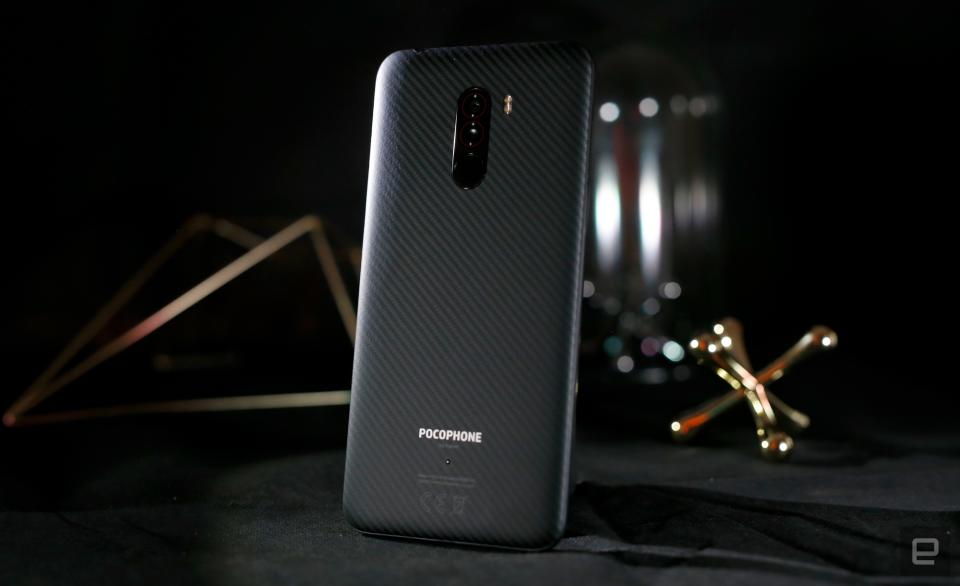Finally, a cheap smartphone with true flagship power
Xiaomi's Pocophone F1 packs a Snapdragon 845 but costs about $300.
Xiaomi is one of the most respected smartphone brands in India, but apparently that wasn't not good enough. Earlier today, the Chinese phone maker launched a new sub-brand called Pocophone, which in turn revealed its new F1 smartphone. Normally, we wouldn't get too worked up over this kind of news, but as it turns out, Pocophone's F1 is a fascinating little machine. See, the F1 isn't an aspirational device. It doesn't carry the same cachet has a high-end iPhone or Galaxy. Pocophone's philosophy is too pragmatic for that. What it does offer, however, is true flagship power in a package that should cost far less than rivals like the OnePlus 6. The phone's final price tag will vary depending on region, but in its native India, the base Pocophone F1 will cost phone fans ₹20,999 (that's about $300) according to Pocophone product head Jai Mani. That makes the F1 one of the cheapest phones -- if not the cheapest, period -- out there using Qualcomm's flagship Snapdragon 845 chipset. Companies like OnePlus have found success in offering premium performance on a budget, but Pocophone's approach takes things a step further. For the upstart brand, it's not just about maxing out benchmarks -- it's about nailing down a mix of features people actually care about. "I see this in your comments section, and definitely on r/Android," Mani told Engadget. "People are like 'Hey, I just want a manufacturer to make a [Snapdragon] 845 phone with a big battery, and I don't need glass.' And someone else will come back with 'Hey, we're nerds. No manufacturer will ever make a phone just for us because we're too small a market,' and to an extent that's true." The loophole here is that while big phone makers have images and reputations to maintain, they can easily create separate brands that are free to fiddle with the status quo. That's where Xiaomi's Pocophone comes in. In addition to that Snapdragon 845, the brand's base level F1 comes loaded with 6GB of RAM, 64GB of storage, while the pricier model ups the ante with 8GB of RAM and up to 256GB of storage. No matter which version of the phone Poco fans shell out for, they'll get a 6.18-inch, 18.7:9 LCD screen running at Full HD+, a super-fast rear fingerprint sensor, a 20-megapixel front-facing camera and -- perhaps most important -- a 4,000mAh battery. Pocophone's decision to run with a more capacious battery means the F1 is a little chunkier than similarly spec'd flagship phones, but that's been an easy trade-off to live with. I've easily been able to squeeze 7 hours of screen-on time out of the F1, or about 1.5 to 2 days of fairly consistent use. All told, Poco's first phone is more of a beast than its price tag lets on. The phone sort of feels like a beast, too, since it lacks the trim waistline and glass-heavy design of flagship phones with similar specs. Building a body of polycarbonate (or kevlar, like our test unit) doesn't just help keep costs manageable, it means the phone is less prone to slipping around and crashing to the floor. That has happened to me more times this year than I care to admit, and the F1 dodges that unfortunate trend with ease. The whole point of the F1 was to build a properly powerful machine with logical compromises, but it packs a few features that are nearly unheard of at this price point. Instead of just using the front-facing camera for its Face Unlock feature, Pocophone squeezed an infrared illuminator and camera into the notch to make sure it still works in the dark. And a liquid cooling system ferries heat away from the Snapdragon's processor cores, all to keep things running smoothly under heavy, sustained loads. These are things we've come to expect from phones that cost nearly $1,000 — to find them in a device that costs less than a third of that is honestly a little perplexing. It helps that, despite operating with a fair degree of independence inside its parent company, Pocophone gets to tap into Xiaomi's extensive supply chain. According to Mani, that means Poco gets access to valuable new components -- like that Snapdragon 845 -- at a price most upstarts wouldn't be able to finagle. It's not hard to look at Pocophone's relationship with Xiaomi as roughly analogous to OnePlus's relationship with Oppo -- both of those smaller smartphone brands largely have free rein to do their own thing, but they benefit from some serious resources on the back end. While the dividing line between Pocophone and the rest of Xiaomi can be a little murky, it seems like their collective work has mostly paid off. I've been using the phone for over a week now, and two things have become perfectly clear. First, this phone has game. My daily routine consists of jumping between multiple apps frequently for work, plus some extended downtime with apps like YouTube and PUBG Mobile. The F1 handled everything I threw at it with gusto — PUBG in particular ran very well (no dropped frames here) and I'm looking forward to taking Fortnite for a spin on it once it's a little further along in its beta. Then again, none of this should come as a surprise considering the kind of hardware we're working with. Secondly, even the dual camera around back -- which pairs a 12-megapixel, f/1.9 Sony sensor with a 5-megapixel sensor for depth effects -- performs better than expected considering the phone's price. Neither sensor has OIS and MIUI's AI photography features don't seem quite as handy as others we've tested this year, but this dual camera is more than respectable considering the price. And it's worth mentioning that the F1's battery life is great — I really wish more smartphone makers would embrace bigger bodies and the larger batteries they could accommodate. With all that said, the other thing to keep in mind about the F1 is that it's a roughly $300 phone — it's definitely not going to be perfect. In my week of testing, the phone's screen made that point most obvious. It's bright and vivid, sure, but there's a barely perceptible bit of latency for touch inputs that sometimes makes the phone feel a little less responsive than it should. At this point, it's hard to tell whether the issue is due to software that needs tweaking or a lousy digitizer, but it's there all the same. But again, this is a phone that, in the right markets, will cost significantly less than competitors with many of the same features. Compromise was inevitable, and on the whole Pocophone struck an impressive balance between price and performance. Customers in India will get first crack at the F1, but Mani confirmed that the phone would eventually make its way to European markets where Xiaomi already has a considerable presence. And while there are no concrete plans to bring the Pocophone to the US, Mani wouldn't rule out that possibility entirely for future devices. It apparently all boils down to the level of support people around here show for the device. "I think if we get a really good response, then for the next device we definitely look at [the US] a lot more strongly," Mani said.



















